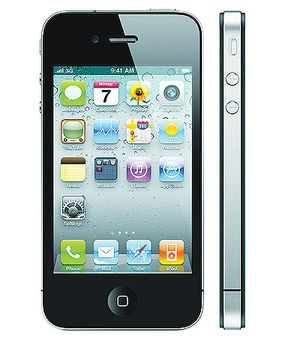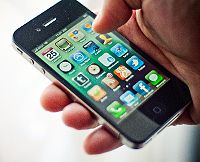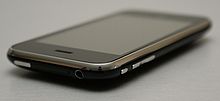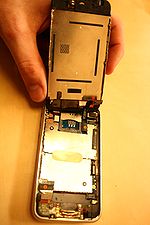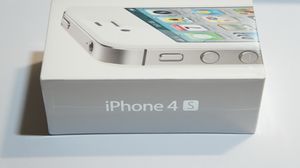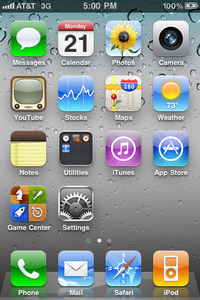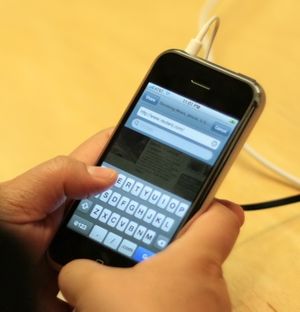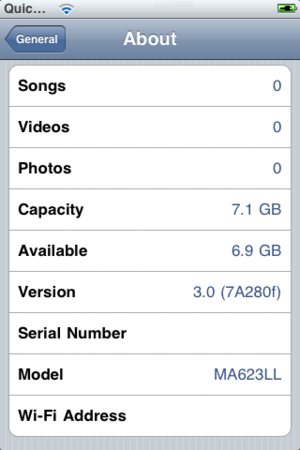آيفون 4ج
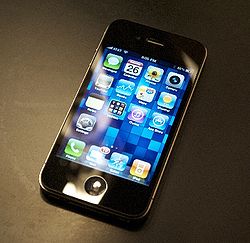 | |
| Developer | Apple Inc. |
|---|---|
| Manufacturer | Foxconn (OEM)[1] |
| Type | Slate smartphone |
| Release date | June 29, 2007[2] |
| Units sold | 50 million اعتبارا من 8 أبريل 2010[تحديث][3] |
| Operating system | iOS, formerly known as iPhone OS |
| Power | Internal rechargeable non-removable Li-ion battery[4] |
| CPU | Varies by model |
| Storage capacity | Flash memory Capacity varies by model |
| Memory | eDRAM,[5] capacity by model |
| Display | 2:3 aspect ratio, 18-bit LCD 640x960 pixels for iPhone 4 |
| Input | See article |
| Camera | Yes, varies by model |
| Connectivity | See article |
| Online services | iTunes Store, App Store, MobileMe, iBooks |
| Related articles | iPod Touch, iPad Models: Original, 3G, 3GS, 4 |
| Website | Apple – iPhone |
«و 'آي فون' (تــُنطـَق /ˈaɪ.foʊn/ EYE-fohn) هو خط مجهز لتصفح الإنترنت وعرضالوسائط- هاتف ذكى تم تصميمه وتسويقه بواسطة شركة أبل , حيث كان آيفون(الأساسى) قد تم إصداره في 9, 2007.[6] وظائف آيفون هاتف كاميرا ، بما في ذلك الرسائل النصية و البريد الصوتي المرئي ، وهو يعد هاتف لاعب وسائط محمولة ، و هاتف مرتبط بالإنترنت ، مع البريد الإلكتروني ، متصفح الإنترنت ، و إتصال واي فاي . واجهة المستخدم بنيت حول خاصية الجهاز بشاشة المتعددة-اللمس, وتشمل لوحة مفاتيح إفتراضية بدلا من لوحة مفاتيح إعتيادية. وتطبيقات من طرف ثالث المتوفرة من خلال متجر التطبيقات التى إنطلقت في منتصف عام -2008 و تشمل الآن مايقارب 200,000 من التطبيقات. [7] "التطبيقات" التى أقرتها أبل. تشمل مجالات متنوعة , من ضمنها العاب الفيديو, أعمال مرجعية, GPS تجوال, خدمات الشبكات الإجتماعية, و الإعلان بخصوص العروض المتلفزة, الأفلام, و عروض المناسبات.
ويتوافر قائمة بأربعة أجيال معدات صلبة للآيفون ترافقت مع أربعة إصدارات نظم تشغيل iOS كانت تدعى سابقا iPhone OS). بينما يعد أول إصدار للآيفون رسخت تصاميم سابقة مثل حجم الشاشة ومواضع الأزرار التى إستمرت طيلة كل النماذج السابقة . فيعد آيفون 3G هو الذى جلب إمكانات الشبكة الخلوية 3G و A-GPS نظم تحديد المواقع. و ايضا أسهم آيفون 3GS في جلب البوصلة, ومعالج فائق السرعة, و كاميرا عالية التحديد, و تشمل عروض الفيديو. بينما يعد آيفون 4ج الحالى المحتوى على زوج من الكاميرات مساهما في FaceTime مكالمات الفيديو كول وشاشة عرض عالية الوضوح. وتم إطلاقه في 24 يونيو 2010 في بعض البلدان وتتم عملية إطلاقه في جميع أنحاء العالم.
.
التاريخ والتوافر

بدأت عملية التطوير في اي فون أبل مع اتجاه الرئيس التنفيذي لشركة أبل ستيف جوبز 'لتوجيه مهندسى أبل لتطبيق وتتحقيق شاشات اللمس المتعدد.[8] طورت أبل الجهازخلال تعاون سرى غير مسبوق مع AT&T Mobility—Cingular Wireless في وقت —بتكلفة تطوير قدرت ب 150 مليون دولار أمريكي over thirty months.[9] رفضت أبل التصميم "من قبل لجنة" النهج الذي أثمر عن ظهور جهاز موتورولا ROKR E1, التعاون غير ناجح إلى حد كبير مع موتورولا .وبدلا من ذلك ، فقد سمحت سينجيولار لأبل بالحرية لتطوير جهاز اي فون والبرمجيات الخاصة به في عقر دارها.[10][11]
Jobs unveiled the iPhone to the public on January 9, 2007 in a keynote address. Apple was required to file for operating permits with the FCC, but since such filings are made available to the public, the announcement came months before the iPhone had received approval. The iPhone went on sale in the United States on June 29, 2007, at 6:00 pm local time, while hundreds of customers lined up outside the stores nationwide.[12] The original iPhone was made available in the UK, فرنسا, and ألمانيا in November 2007, and Ireland and Austria in the spring of 2008.
On July 11, 2008, Apple released the iPhone 3G in twenty-two countries, including the original six.[13] Apple has since released the iPhone 3G in upwards of eighty countries and territories.[14] Apple announced the iPhone 3GS on June 8, 2009, along with plans to release it later in June, July, and August, starting with the U.S., Canada and major European countries on June 19. Many would-be users have objected to the iPhone's cost,[15] and 40% of users have household incomes over 100,000 USD.[16] In an attempt to gain a wider market, Apple has retained the 8 GB iPhone 3G at a lower price point. This is the latest of several price reductions since the iPhone's release in 2007; it now[when?] sells for one-sixth of the price of the original 8 GB iPhone when it first became available. In the U.S., it now[when?] costs $99, down from $599, although it requires a two-year contract and a SIM lock.
Apple sold 6.1 million original iPhone units over five quarters.[17] The company sold 3.8 million iPhone 3G units in the second quarter of fiscal 2009, ending March 2009, and 12.6 million 3G and 3GS combined, totaling 33.75 million iPhones sold to date (Q4 2009).[18] Sales in Q4 2008 surpassed temporarily those of RIM's BlackBerry sales of 5.2 million units, which made Apple briefly the third largest mobile phone manufacturer by revenue, after Nokia and Samsung.[19] Approximately 6.4 million iPhones are active in the U.S. alone.[16] While iPhone sales constitute a significant portion of Apple's revenue, some of this income is deferred.[18]
The back of the original iPhone was made of aluminum with a black plastic accent. The iPhone 3G and 3GS feature a full plastic back to increase the strength of the GSM signal.[20] The iPhone 3G was available in an 8 GB black model, or a black or white option for the 16 GB model. They both are now discontinued. The iPhone 3GS is available in both colors, regardless of storage capacity. The white model has now[when?] been discontinued.[بحاجة لمصدر] The iPhone 4 has an aluminosilicate glass front and back with a stainless steel edge that serves as the antennae. It too is available in black or white.
The iPhone has garnered positive reviews from critics like David Pogue[21] and Walter Mossberg.[22][23] The iPhone attracts users of all ages.[16]
العتاد الصلب
المعالج
ويستخدم الجهاز الجديد معالج «إيه 4» A4 (المعالج نفسه المستخدم في جهاز «آي باد»)، وهو يقدم سرعة أكبر في العمل (أفضل من تلك الموجودة في إصدار «آي فون 3 جي إس») وتوفيرا أفضل للطاقة الكهربائية. وبالحديث عن الطاقة الكهربائية، يستخدم الجهاز الجديد بطارية أفضل من السابق، نظرا لاستخدام الجهاز دارات ومكونات أصغر، وبالتالي توفير مساحة أكبر للبطارية. وتستطيع البطارية الجديدة العمل لنحو 7 ساعات من التحدث المتواصل (مقارنة بـ5 في الإصدار السابق)، أو 14 ساعة من دون استخدام شبكات الجيل الثالث (مقارنة بـ12 في الإصدار السابق)، أو 10 ساعات من تصفح الإنترنت عبر شبكات «واي فاي» اللاسلكية، أو 6 ساعات من تصفح الإنترنت عبر شبكات الجيل الثالث، أو 40 ساعة من تشغيل الموسيقى، أو 10 ساعات من تشغيل عروض الفيديو. وأضيف ميكروفون جديد في أعلى الهاتف، وظيفته هي الاستماع إلى أصوات البيئة ومقارنتها بصوت المستخدم، ومن ثم إلغاء الضجيج والضوضاء برمجيا، لرفع نقاء الصوت بشكل ملحوظ.
الشاشة والإدخال
إن شاشة اللمس عبارة عن 9 سم (3.5 بوصة) شاشة عرض سائل (320×480 بيكسل at 6.3 بيكسل/مم, 163 ppi, HVGA) مع زجاج مضاد للخدوش [24] و18-بتا من الألوان (إظهار الألوان 262,144 ). وقد صممت شاشة المس السعوية كى تتحمل إصبعا منفردا أو العديد من الأصابع, كى تؤدى وظيفة إستشعار اللمس المتعدد .
ويستخدم الجهاز شاشة جديدة يبلغ قطرها 3.5 بوصة وتعمل بدقة 640x960 بيكسل، أطلق عليها اسم «شاشة الشبكية» Retina Display، التي تستخدم كثافة عرض تبلغ 326 نقطة لكل بوصة مربعة، وبنسبة تباين تبلغ 800:1، وهي تعمل بتقنية الدايودات (الصمامات الثنائية) الباعثة للضوء LED، الأمر الذي يزيد من وضوح الصور المعروضة بشكل كبير مقارنة بالشاشات الأخرى. وأضافت «آبل» مجسا جديدا يتعرف عند تحريك الجهاز إلى الداخل أو الخارج، ليصبح بمقدوره التعرف على ميلانه في 6 اتجاهات مختلفة.
أما خواص اللمس وإستشعار إيحاءات الأصابع للآيفون فقد بنيت حول إبتكار طور بواسطة FingerWorks.[25] كل مايرتدى من قفازات أو بإستعمال القلم styluses تعيق التوصيل الكهربى المطلوب لإستشعار اللمس المتعدد.[26][27][28][29] الهاتف آيفون 3GS مزود أيضا بخاصية مقاومة بصمات الإصبع fingerprint-resistant oleophobic غلاف .[30]
اي فون لديه الحد الأدنى من واجهة المستخدم للأجهزة ، ولايضم سوى أربعة أو خمسة أزرار ضغط ، اعتمادا على ما إذا كان الاعتماد على التحكم في الصوت وزر واحد أو اثنين. ويقع هذا الزر مباشرة أسفل الشاشة ، ويسمى زر "الوطن" أو Home لأنه يغلق التطبيق النشط وبالانتقال إلى الشاشة الرئيسية للواجهة. The home button is denoted not by a house, as on many other similar devices, but a rounded square, reminiscent of the shape of icons on the home screen. A multifunction sleep/wake button is located on the top of the device. It serves as the unit's power button, and also controls phone calls. When a call is received, pressing the sleep/wake button once silences the ringtone, and when pressed twice transfers the call to voicemail. Situated on the left spine are the volume adjustment controls. The iPhone 4 has two separate circular buttons to increase and decrease the volume; all earlier models house two switches under a single plastic panel, known as a rocker switch. Directly above the volume controls is a silence button that mutes all sound when engaged. All buttons except Home were made of plastic on the original iPhone and metal on all later models. The touchscreen furnishes the remainder of the user interface.
The display responds to three sensors. A proximity sensor deactivates the display and touchscreen when the device is brought near the face during a call. This is done to save battery power and to prevent inadvertent inputs from the user's face and ears. An ambient light sensor adjusts the display brightness which in turn saves battery power. A 3-axis accelerometer senses the orientation of the phone and changes the screen accordingly, allowing the user to easily switch between portrait and landscape mode.[31] Photo browsing, web browsing, and music playing support both upright and left or right widescreen orientations.[32] Unlike the iPad, the iPhone does not rotate the screen when turned upside-down, with the Home button above the screen. The 3.0 update added landscape support for still other applications, such as email, and introduced shaking the unit as a form of input.[33][34] The accelerometer can also be used to control third party apps, notably games. The iPhone 4 also includes a gyroscopic sensor, enhancing its perception of how it is moved.
A software update in January 2008[35] allowed the first generation iPhone to use cell tower and Wi-Fi network locations trilateration,[36] despite lacking GPS hardware. The iPhone 3G, 3GS and 4 employ A-GPS, and the iPhone 3GS and 4 also have a digital compass.[37]
Audio and output

The bottom of the iPhone sports a speaker (left) and a microphone (right) flanking the dock connector. One loudspeaker is located above the screen as an earpiece, and another is located on the left side of the bottom of the unit, opposite a microphone on the bottom-right. The iPhone 4 includes an additional microphone at the top of the unit for noise cancellation, and switches the placement of the microphone and speaker on the base on the unit — the speaker is on the left.[38] Volume controls are located on the left side of all iPhone models and as a slider in the iPod application. Both speakers are used for handsfree operations and media playback.
The 3.5 mm TRRS connector for the headphones is located on the top left corner of the device.[39] The headphone socket on the original iPhone is recessed into the casing, making it incompatible with most headsets without the use of an adapter.[40][41] Other generations eliminates the issue with a flush-mounted headphone socket. Cars equipped with an auxiliary jack allow for handsfree use of the iPhone while driving as a substitute for Bluetooth.
While the iPhone is compatible with normal headphones, Apple provides a headset with additional functionality. A multipurpose button near the microphone can be used to play or pause music, skip tracks, and answer or end phone calls without touching the iPhone. A small number of third-party headsets specifically designed for the iPhone also include the microphone and control button.[42] Apple sells headsets with volume controls, but they are only compatible more recent models.[43] These features are achieved by a fourth ring in the audio jack that carries this extra information.
The built-in Bluetooth 2.x+EDR supports wireless earpieces and headphones, which requires the HSP profile. Stereo audio was added in the 3.0 update for hardware that supports A2DP.[33][34] While non-sanctioned third-party solutions exist, the iPhone does not officially support the OBEX file transfer protocol.[44] The lack of these profiles prevents iPhone users from exchanging multimedia files, such as pictures, music and videos, with other bluetooth-enabled cell phones.
Composite or component video at up to 576i and stereo audio can be output from the dock connector using an adapter sold by Apple.[45] The iPhone did not support voice recording until the 3.0 software update.[33][34]
البطارية
آيفون يتميز ببطارية داخلية قابلة لإعادة الشحن. مثل آي بود ولكن خلافا لمعظم أجهزة الهاتف المحمول الأخرى ، فالبطارية لا يمكن استبدالها من قبل المستخدم.[40][46] يمكن شحن آيفون فور توصيله بجهاز الكمبيوتر للحصول على المزامنة عبر الشحن من خلال كابل يو إس بي موصل ، على غرار الاتصال آيبود. بدلا من ذلك ، يو إس بي إلى محول التيار المتردد (أو "الشاحن الجدارى" ، وتشمل أيضا) ان تكون مرتبطة الى كابل كهربي مباشر من المقابس مخرج تيار متردد و عديد من إكسسوارات طرف ثالث (شاحن سيارة , و حتى شاحن شمسى ) متوافر أيضا.[47]
Apple runs tests on preproduction units to determine battery life. Apple's website says that the battery life "is designed to retain up to 80% of its original capacity after 400 full charge and discharge cycles",[48] which is comparable to iPod batteries. The original iPhone's battery was stated to be capable of providing up to seven hours of video, six hours of web browsing, eight hours of talk time, 24 hours of music or up to 250 hours on standby.[24] The iPhone 3G's battery is stated to be capable of providing up to seven hours of video, six hours of web browsing on Wi-Fi or five on 3G, ten hours of 2G talk time, or five on 3G, 24 hours of music, or 300 hours of standby.[49] Apple claims that the 3GS can last for up to ten hours of video, nine hours of web browsing on Wi-Fi or five on 3G, twelve hours of 2G talk time, or five on 3G, 30 hours of music, or 300 hours of standby.[50]
The battery life of the iPhone has been criticized by several technology journalists as insufficient and less than Apple's claims.[51][52][53][54] This is also reflected by a J. D. Power and Associates customer satisfaction survey, which gave the "battery aspects" of the iPhone 3G its lowest rating of 2 out of 5 stars.[55][56]
If the battery malfunctions or dies prematurely, the phone can be returned to Apple and replaced for free while still under warranty.[57] The warranty lasts one year from purchase and can be extended to two years with AppleCare. Though the battery replacement service and its pricing was not made known to buyers until the day the product was launched,[58][59] it is similar to how Apple (and third parties) replace batteries for iPods. The Foundation for Taxpayer and Consumer Rights, a consumer advocate group, has sent a complaint to Apple and AT&T over the fee that consumers have to pay to have the battery replaced.[58] Since July 2007 third party battery replacement kits have been available[60] at a much lower price than Apple's own battery replacement program. These kits often include a small screwdriver and an instruction leaflet, but as with many newer iPod models the battery in the original iPhone has been soldered in. Therefore a soldering iron is required to install the new battery. The iPhone 3G uses a different battery fitted with a connector that is easier to replace, although replacement by any besides Apple still voids the warranty.[61]
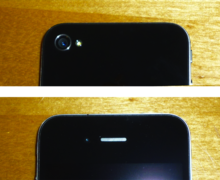
الكاميرا
الآيفون والآيفون 3G يتميزان بعدسة ذات بعد ثابت 3G 2.0 ميجابكسل كاميرا مثبتة بالخلف صور ثابتة. ولا تتميز بزوم بصرى,أو وميض أو أوتوفوكاس, ولا تدعم تصوير الفيديو, و مع ذلك كسر حماية تمكن المستخدمين من أداء ذلك. النسخة 2.0 من الفرموير نظام تشغيل iPhone OS أدخلت خاصية embed location dataفى إنتاج الصور, geocoded photograph.
وطورت كاميرا الجهاز الخلفية لتصبح دقتها 5 ميغابيكسل، مع استخدام فلاش يعمل بتقنية الدايودات الباعثة للضوء LED لالتقاط الصور في ظروف الإضاءة المنخفضة، والحصول على جودة صور عالية الجودة. هذا، وتستطيع الكاميرا التقاط عروض الفيديو بدقة 720 التسلسلية Progressive، الأمر الذي يفتح المجال لتحويل أي مستخدم نفسه، إلى صحافي وإلى آلة تصوير متنقلة تستطيع تحميل الحدث فورا إلى الإنترنت أثناء حدوثه. هذا، ويمكن تحرير عروض الفيديو المسجلة مباشرة من الجهاز، وذلك باستخدام برنامج «آي موفي» iMovie الاحترافي.
ومع إضافة كاميرا أمامية جديدة إلى الجهاز، أصبح بإمكان مستخدمي «آي فون 4» إجراء مكالمات الفيديو عبر شبكات «واي فاي» اللاسلكية، ولكن هذه الميزة تعمل فقط بين مستخدمي «آي فون 4»، عبر برنامج اسمه «فيس تايم» FaceTime.
The iPhone 3GS has a 3.2 megapixel camera, manufactured by OmniVision, featuring autofocus, auto white balance, and auto macro (up to 10 cm). It is also capable of capturing 640x480 (VGA resolution) video at 30 frames per second,[62] although compared to higher-end CCD based video cameras it does exhibit the rolling shutter effect.[63] The video can then be cropped on the device itself and directly uploaded to YouTube, MobileMe, or other services
The iPhone 4 introduced a 5.0 megapixel camera, also located on the back, which is equipped with a backside illuminated sensor capable of capturing pictures in low-light conditions, as well as an LED flash capable of staying lit for video recording at 720p resolution.[64] In addition the iPhone 4 has a second camera on the front capable of VGA photos and video recording.
Storage and SIM
The iPhone was initially released with two options for internal storage size: 4 GB or 8 GB. On September 5, 2007, Apple discontinued the 4 GB models.[65] On February 5, 2008, Apple added a 16 GB model.[66] The iPhone 3G was available in 16 GB and is still available with 8 GB. The iPhone 3GS comes in 16 GB and 32 GB variants. All data is stored on the internal flash drive; the iPhone does not support expanded storage through a memory card slot, or the SIM card.
The SIM card sits in a tray, which is inserted into a slot at the top of the device. The SIM tray can be ejected with a paperclip or the "SIM eject tool" (a simple piece of die-cut sheet metal) included with the iPhone 3G and 3GS.[67][68] In most countries, the iPhone is usually sold with a SIM lock, which prevents the iPhone from being used on a different mobile network.[69]
The iPhone 4 features a new MicroSIM card that is located in a slot on the right side of the device.[70]
Moisture sensors
Like many modern electronics devices,[بحاجة لمصدر] the iPhone has moisture sensors to indicate whether water damage has affected a device. The sensors on an iPhone include a small disc which is located in the headphone jack and an area near the dock connector.[71] The sensors are often used by Apple employees to determine whether the device qualifies for a warranty repair or replacement, and if the sensors show that the device has absorbed moisture they may determine that the device is not covered. However, the moisture sensors might be "tripped" through routine use, and if a device is worn while exercising the sweat from an owner may dampen the sensors enough to indicate water damage.[72] On many other mobile phones from different manufacturers, the moisture sensors are located in a protected location, such as beneath the battery behind a battery cover, but the sensors on an iPhone are directly exposed to the environment. This has led to criticism of the placement of the sensors, which may also be affected by steam in a bathroom or other light environmental moisture.[73]
Included items
All iPhone models include written documentation, and a dock connector to USB cable. The original and 3G iPhones also came with a cleaning cloth. The original iPhone included stereo headset (earbuds and a microphone) and a plastic dock to hold the unit upright while charging and syncing. The iPhone 3G includes a similar headset plus a SIM eject tool (the original model requires a paperclip). The iPhone 3GS includes the SIM eject tool and a revised headset, which adds volume buttons.[43] The iPhone 3G and 3GS are compatible with the same dock, sold separately, but not the original model's dock.[74] All versions include a USB power adapter, or "wall charger," which allows the iPhone to charge from an AC outlet. The iPhone 3G and iPhone 3GS sold in North America, Japan, Colombia, Ecuador, or Peru[75][76] include an ultracompact USB power adapter.
Models
| Model | Capacity | RAM[77] | Connection | Original release date | Minimum OS to sync | Rated battery life (hours) |
|---|---|---|---|---|---|---|
| Original | 4 GB 8 GB |
128 MB | USB via dock connector (FireWire for charging only)[78] | June 29, 2007 | Mac: 10.4 Win: XP |
audio: 22 video: 5 |
| 16 GB | February 5, 2008 | |||||
| First phone with a Multi-Touch interface. Features include: Safari web browser and wireless access to the iTunes Store and YouTube. 16 GB version later added. | ||||||
| 3G | 8 GB 16 GB |
128 MB | USB via dock connector | July 11, 2008 | Mac: 10.4 Win: XP |
audio: 24 video: 7[79] |
| Full white or black hard plastic back and metallic volume buttons. Features include iPhone OS 2.0, App Store, 3G connectivity, and GPS. | ||||||
| 3GS | 16 GB 32 GB |
256 MB | USB via dock connector | June 19, 2009 | Mac: 10.4 Win: XP |
audio: 30 video: 10 |
| 8 GB | June 24, 2010 | |||||
| Oleophobic-coated screen. Features include an upgraded CPU processor and graphics processor and increased RAM; support for video recording, higher resolution camera, includes Voice Control support, and includes iPhone OS 3. However the 8GB version comes with iOS 4 installed.[80] | ||||||
| 4 | 16 GB 32 GB |
512 MB[81] | USB via dock connector | June 24, 2010 | Mac: 10.5.8 Win: XP |
audio: 40 video: 10 |
| Aluminosilicate glass front and back panels with a stainless steel antenna band around the sides.[82] Features include an Apple A4 processor, 960x640, 326 ppi IPS display, 5 megapixel back camera with LED flash and HD video recording, a VGA front-facing camera and a gyroscope providing greater motion sensitivity. Ships with iOS 4. | ||||||
Software
The iPhone (and iPod Touch) run an operating system known as iOS (formerly iPhone OS). It is a variant of the same Darwin operating system core that is found in Mac OS X. Also included is the "Core Animation" software component from Mac OS X v10.5 Leopard. Together with the PowerVR hardware (and on the iPhone 3GS, OpenGL ES 2.0), it is responsible for the interface's motion graphics. The operating system takes up less than half a GB of the device's total storage (4 to 32 GB).[83] It is capable of supporting bundled and future applications from Apple, as well as from third-party developers. Software applications cannot be copied directly from Mac OS X but must be written and compiled specifically for iOS.
نظام تشغيل جديد
وطرحت الشركة نظام التشغيل الجديد «آي أو إس 4.0» أمس، بعد الاستجابة لطلبات المستخدمين، وفي محاولة للهيمنة على سوق الهواتف الجوالة (وخصوصا مع منافسة نظام التشغيل «آندرويد» من «غوغل»، ونظم «ويندوز موبايل 7» و«ميغو» MeeGo المقبلة من «مايكروسوفت» و«نوكيا»)، ذلك أن المواصفات التقنية لأي هاتف ليست كافية لإقناع المستخدمين بشراء الجهاز إن لم يكن نظام التشغيل سلسا ومريحا للاستخدام، ويقدم الكثير من المزايا المفيدة. وتجدر الإشارة إلى أن النظام ليس متوافقا مع الجيل الأول لأجهزة «آي فون» و«آي بود تاتش».
ومن أهم مزايا الإصدار الجديد أنه يسمح بتعدد المهام بين البرامج Multitasking، بحيث يعمل جزء فقط من البرنامج في الخلفية، مع إمكانية استخدام 7 أقسام بشكل متعدد، هي تشغيل صوت في الخلفية، وحفظ حالة البرنامج والعودة إليه في أي وقت، والقدرة على تحديد الموقع الجغرافي، وتلقي المكالمات الصوتية من البرامج (مثل «سكايب»)، وإرسال رسائل «بوش» Push للتنبيه عند حدوث أمر ما، وتنبيه برنامج يعمل في الخلفية عند الانتهاء من عمله (مثل تحميل الملفات)، وإرسال الرسائل من برنامجك مباشرة، ومن دون استخدام الإنترنت. وبالإمكان لأي قسم من الأقسام المذكورة العمل حتى لو كان برنامجه لا يعمل في ذلك الوقت.
ويقدم النظام الجديد أكثر من 1500 واجهة تفاعل برمجية API جديدة تخدم المبرمجين، منها لإرسال الرسائل القصير من البرامج، والتفاعل مع تقويم الجهاز، وتحكم أفضل بخرائط «غوغل»، والقدرة على التفاعل مباشرة مع الكاميرا.
ومن المزايا المهمة في النظام الجديدة قدرته على تجميع برامجك المفضلة في مجلدات مختلفة (وفقا لاختيارك)، وفي أي وقت تريده، ولكن مع وجود شرط واحد، هو عدم قدرة أي مجلد على تخزين أكثر من 12 تطبيقا في الوقت نفسه. وبمعرفة أن النظام يسمح لك وضع 180 أيقونة على سطح المكتب (عبر عدة صفحات)، وبافتراض أن جميع الأيقونات هي لمجلدات، فإن العدد النهائي للبرامج التي يمكن تخزينها على الجهاز هي 180x12=2160 برنامجا! وبإمكان المستخدم تغيير خلفية سطح المكتب (وليس فقط شاشة إغلاق الجهاز)، مع إضافة مؤثرات بصرية لتجسيم شاشة قائمة البرامج، وعرض ظلال للأيقونات، وتغيير أشكال بعضها (مثل الملاحظات الصوتية والآلة الحاسبة). وحدثت «آبل» برنامج البريد الإلكتروني بشكل ملحوظ، بحيث أصبح بإمكانك جمع بريدك في مجلد خاص، وإضافة أكثر من عنوان بريد يعمل بخاصية الـ«بوش»، مع توفير القدرة على فتح ملحقات رسائل البريد الإلكتروني من أي برنامج آخر، واختيار ضغط الصور قبل إرسالها أو إرسالها بحجمها العادي.
Like the iPod, the iPhone is managed with iTunes. The earliest versions of the OS required version 7.3 or later, which is compatible with Mac OS X version 10.4.10 Tiger or later, and 32-bit or 64-bit Windows XP or Vista.[84] The release of iTunes 7.6 expanded this support to include 64-bit versions of XP and Vista,[85] and a workaround has been discovered for previous 64-bit Windows operating systems.[86] Apple provides free updates to the OS for the iPhone through iTunes,[83] and major updates have historically accompanied new models.[87] Such updates often require a newer version of iTunes — for example, the 3.0 update requires iTunes 8.2 — but the iTunes system requirements have stayed the same. Updates include both security patches and new features.[88] For example, iPhone 3G users initially experienced dropped calls until an update was issued.[89][90]
Interface
The interface is based around the home screen, a graphical list of available applications. iPhone applications normally run one at a time, although most functionality is still available when making a call or listening to music. The home screen can be accessed at any time by a hardware button below the screen, closing the open application in the process.[91] By default, the Home screen contains the following icons: Messages (SMS and MMS messaging), Calendar, Photos, Camera, YouTube, Stocks, Maps (Google Maps), Weather, Voice Memos, Notes, Clock, Calculator, Settings, iTunes (store), App Store, and (on the iPhone 3GS only) Compass. Docked at the base of the screen, four icons for Phone, Mail, Safari (Internet), and iPod (multimedia) delineate the iPhone's main purposes.[92] On January 15, 2008, Apple released software update 1.1.3, allowing users to create "Web Clips", home screen icons that resemble apps that open a user-defined page in Safari. After the update, iPhone users can rearrange and place icons on up to nine other adjacent home screens, accessed by a horizontal swipe.[35] Users can also add and delete icons from the dock, which is the same on every home screen. Each home screen holds up to sixteen icons, and the dock holds up to four icons. Users can delete Web Clips and third-party applications at any time, and may select only certain applications for transfer from iTunes. Apple's default programs, however, may not be removed. The 3.0 update adds a system-wide search, known as Spotlight, to the left of the first home screen.[33][34]
Almost all input is given through the touch screen, which understands complex gestures using multi-touch. The iPhone's interaction techniques enable the user to move the content up or down by a touch-drag motion of the finger. For example, zooming in and out of web pages and photos is done by placing two fingers on the screen and spreading them farther apart or bringing them closer together, a gesture known as "pinching". Scrolling through a long list or menu is achieved by sliding a finger over the display from bottom to top, or vice versa to go back. In either case, the list moves as if it is pasted on the outer surface of a wheel, slowly decelerating as if affected by friction. In this way, the interface simulates the physics of a real object. Other user-centered interactive effects include horizontally sliding sub-selection, the vertically sliding keyboard and bookmarks menu, and widgets that turn around to allow settings to be configured on the other side. Menu bars are found at the top and bottom of the screen when necessary. Their options vary by program, but always follow a consistent style motif. In menu hierarchies, a "back" button in the top-left corner of the screen displays the name of the parent folder.
Phone
The iPhone allows audio conferencing, call holding, call merging, caller ID, and integration with other cellular network features and iPhone functions. For example, if a song is playing while a call is received, it gradually fades out, and fades back when the call has ended. The proximity sensor shuts off the screen and touch-sensitive circuitry when the iPhone is brought close to the face, both to save battery and prevent unintentional touches. The iPhone does not support video calling or videoconferencing on versions prior to the 4th generation, as there is only one camera on the opposite side of the screen.[93] The iPhone 4 supports video calling using either the front or back camera over wi-fi, a feature Apple calls "Facetime".[94] The first two models only support voice dialing through third party applications.[95] Voice control, available only on the iPhone 3GS, allows users to say a contact's name or number and the iPhone will dial.[96]
The iPhone includes a visual voicemail (in some countries)[97] feature allowing users to view a list of current voicemail messages on-screen without having to call into their voicemail. Unlike most other systems, messages can be listened to and deleted in a non-chronological order by choosing any message from an on-screen list.
A music ringtone feature was introduced in the United States on September 5, 2007. Users can create custom ringtones from songs purchased from the iTunes Store for a small additional fee. The ringtones can be 3 to 30 seconds long from any part of a song, can fade in and out, pause from half a second to five seconds when looped, or loop continuously. All customizing can be done in iTunes,[98] or alternatively with Apple's GarageBand software 4.1.1 or later (available only on Mac OS X)[99] or third-party tools.[100]
Multimedia
The layout of the music library is similar to that of an iPod or current Symbian S60 phones. The iPhone can sort its media library by songs, artists, albums, videos, playlists, genres, composers, podcasts, audiobooks, and compilations. Options are always presented alphabetically, except in playlists, which retain their order from iTunes. The iPhone uses a large font that allows users plenty of room to touch their selection. Users can rotate their device horizontally to landscape mode to access Cover Flow. Like on iTunes, this feature shows the different album covers in a scroll-through photo library. Scrolling is achieved by swiping a finger across the screen. Alternatively, headset controls can be used to pause, play, skip, and repeat tracks. On the iPhone 3GS, the volume can be changed with the included Apple Earphones, and the Voice Control feature can be used to identify a track, play songs in a playlist or by a specific artist, or create a Genius playlist.[96]
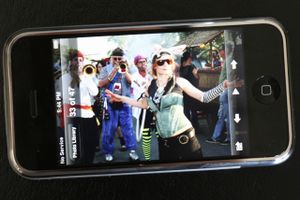
The iPhone supports gapless playback.[101] Like the fifth generation iPods introduced in 2005, the iPhone can play digital video, allowing users to watch TV shows and movies in widescreen. Double-tapping switches between widescreen and fullscreen video playback.
The iPhone allows users to purchase and download songs from the iTunes Store directly to their iPhone. The feature originally required a Wi-Fi network, but now[when?] can use the cellular data network if one is not available.[102]
The iPhone includes software that allows the user to upload, view, and e-mail photos taken with the camera. The user zooms in and out of photos by sliding two fingers further apart or closer together, much like Safari. The Camera application also lets users view the camera roll, the pictures that have been taken with the iPhone's camera. Those pictures are also available in the Photos application, along with any transferred from iPhoto or Aperture on a Mac, or Photoshop in Windows.
Internet connectivity
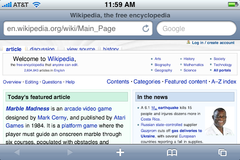
Internet access is available when the iPhone is connected to a local area Wi-Fi or a wide area GSM or EDGE network, both second-generation (2G) wireless data standards. The iPhone 3G introduced support for third-generation UMTS and HSDPA 3.6,[103] but not HSUPA networks, and only the iPhone 3GS supports HSDPA 7.2.[104] AT&T introduced 3G in July 2004,[105] but as late as 2007 Steve Jobs stated that it was still not widespread enough in the US, and the chipsets not energy efficient enough, to be included in the iPhone.[27][106] Support for 802.1X, an authentication system commonly used by university and corporate Wi-Fi networks, was added in the 2.0 version update.[107]
By default, the iPhone will ask to join newly discovered Wi-Fi networks and prompt for the password when required. Alternatively, it can join closed Wi-Fi networks manually.[108] The iPhone will automatically choose the strongest network, connecting to Wi-Fi instead of EDGE when it is available.[109] Similarly, the iPhone 3G and 3GS prefer 3G to 2G, and Wi-Fi to either.[110] Wi-Fi, Bluetooth, and 3G (on the iPhone 3G and 3GS) can all be deactivated individually. Airplane mode disables all wireless connections at once, overriding other preferences.
The iPhone 3GS has a maximum download rate of 7.2 Mbit/s.[111] Furthermore, files downloaded over cellular networks must be smaller than 20 MB.[112] Larger files, often email attachments or podcasts, must be downloaded over Wi-Fi (which has no file size limits). If Wi-Fi is unavailable, one workaround is to open the files directly in Safari.[113]
Safari is the iPhone's native web browser, and it displays pages similar to its Mac and Windows counterparts. Web pages may be viewed in portrait or landscape mode and supports automatic zooming by pinching together or spreading apart fingertips on the screen, or by double-tapping text or images.[114][115] The iPhone supports neither Flash[116] nor Java.[117][unreliable source?] Consequently, the UK's Advertising Standards Authority adjudicated that an advertisement claiming the iPhone could access "all parts of the internet" should be withdrawn in its current form, on grounds of false advertising.[118] In a rare public letter in April 2010, Apple CEO Steve Jobs outlined the reasoning behind the absence of Flash on the iPhone (and iPad).[119] The iPhone supports SVG, CSS, HTML Canvas, and Bonjour.[120][121]
The maps application can access Google Maps in map, satellite, or hybrid form. It can also generate directions between two locations, while providing optional real-time traffic information. During the iPhone's announcement, Jobs demonstrated this feature by searching for nearby Starbucks locations and then placing a prank call to one with a single tap.[8][122] Support for walking directions, public transit, and street view was added in the version 2.2 software update, but no voice-guided navigation.[123] The iPhone 3GS can orient the map with its digital compass.[37] Apple also developed a separate application to view YouTube videos on the iPhone, which streams videos after encoding them using the H.264 codec. Simple weather and stock quotes applications also tap in to the Internet.
iPhone users can and do access the Internet frequently, and in a variety of places. According to Google, the iPhone generates 50 times more search requests than any other mobile handset.[124] According to Deutsche Telekom CEO René Obermann, "The average Internet usage for an iPhone customer is more than 100 megabytes. This is 30 times the use for our average contract-based consumer customers."[125] Nielsen found that 98% of iPhone users use data services, and 88% use the internet.[16] In China, the iPhone 3G and iPhone 3GS were built and distributed without Wi-fi.[126]
Text input
For text input, the iPhone implements a virtual keyboard on the touchscreen. It has automatic spell checking and correction, predictive word capabilities, and a dynamic dictionary that learns new words. The keyboard can predict what word the user is typing and complete it, and correct for the accidental pressing of keys near the presumed desired key.[127] The keys are somewhat larger and spaced farther apart when in landscape mode, which is supported by only a limited number of applications. Touching a section of text for a brief time brings up a magnifying glass, allowing users to place the cursor in the middle of existing text. The virtual keyboard can accommodate 21 languages, including character recognition for Chinese.[128] The 3.0 update brought support for cut, copy, or pasting text, as well as landscape keyboards in more applications.[33][34]
E-mail and text messages
The iPhone also features an e-mail program that supports HTML e-mail, which enables the user to embed photos in an e-mail message. PDF, Word, Excel, and Powerpoint attachments to mail messages can be viewed on the phone.[49] Apple's MobileMe platform offers push email, which emulates the functionality of the popular BlackBerry email solution, for an annual subscription. Yahoo! offers a free push-email service for the iPhone. IMAP (although not Push-IMAP) and POP3 mail standards are also supported, including Microsoft Exchange[129] and Kerio Connect.[130] In the first versions of the iPhone firmware, this was accomplished by opening up IMAP on the Exchange server. Apple has also licensed Microsoft ActiveSync and now[when?] supports the platform (including push email) with the release of iPhone 2.0 firmware.[131][132] The iPhone will sync e-mail account settings over from Apple's own Mail application, Microsoft Outlook, and Microsoft Entourage, or it can be manually configured on the device itself. With the correct settings, the e-mail program can access almost any IMAP or POP3 account.[133]
Text messages are presented chronologically in a mailbox format similar to Mail, which places all text from recipients together with replies. Text messages are displayed in speech bubbles (similar to iChat) under each recipient's name. The iPhone currently[when?] has built-in support for e-mail message forwarding, drafts, and direct internal camera-to-e-mail picture sending. Support for multi-recipient SMS was added in the 1.1.3 software update.[134] Support for MMS was added in the 3.0 update, but not for the original iPhone[33][34] and not in the U.S. until September 25, 2009.[135][136]
تطبيقات من طرف ثالث
- See also: iPhone SDK and App Store
At WWDC 2007 on June 11, 2007 Apple announced that the iPhone would support third-party "web applications" written in Ajax that share the look and feel of the iPhone interface.[137] On October 17, 2007, Steve Jobs, in an open letter posted to Apple's "Hot News" weblog, announced that a software development kit (SDK) would be made available to third-party developers in February 2008. The iPhone SDK was officially announced on March 6, 2008, at the Apple Town Hall facility.[138] It allows developers to develop native applications for the iPhone and iPod Touch, as well as test them in an "iPhone simulator". However, loading an application onto the devices is only possible after paying a Apple Developer Connection membership fee. Developers are free to set any price for their applications to be distributed through the App Store, of which they will receive a 70% share.[139] Developers can also opt to release the application for free and will not pay any costs to release or distribute the application beyond the membership fee. The SDK was made available immediately, while the launch of applications had to wait until the firmware update which was released on July 11, 2008.[132] The update was free for iPhone users, but not for owners of iPod Touches with the 1.x release of iPhone OS, whose operating system can be updated to the current version of iPhone OS, so that they can run iPhone applications, only after paying a small fee.[140]
Once a developer has submitted an application to the App Store, Apple holds firm control over its distribution. For example, Apple can halt the distribution of applications it deems inappropriate as has happened with a US$1000 program that has as sole purpose to demonstrate the wealth of its user.[141] Apple has been criticized for banning third party applications that enable a functionality that Apple does not want the iPhone to have. In 2008, Apple rejected Podcaster, which allowed iPhone users to download podcasts directly to the iPhone claiming it duplicated the functionality of iTunes.[142] Apple has since released a software update that grants this capability.[123] NetShare, another rejected app, would have enabled users to tether their iPhone to a laptop or desktop, using its cellular network to load data for the computer.[143]
Before the SDK was released, third-parties were permitted to design "Web Apps" that would run through Safari.[144] Unsigned native applications are also available.[145] The ability to install native applications onto the iPhone outside of the App Store will not be supported by Apple. Such native applications could be broken by any software update, but Apple has stated it will not design software updates specifically to break native applications other than those that perform SIM unlocking.[146]
دعم لغوى واسع
الهيكل الجديد للجهاز معدني وأكثر صلابة من السابق، وهو يعمل كهوائي في الوقت نفسه، الأمر الذي يعني أن جودة الاتصال ستكون مرتفعة. هذا، ويستخدم الجهاز شرائح «مايكرو سيم» MicroSIM للاتصالات، الأمر الذي قد يحد من انتشار الأجهزة غير المغلقة على شبكات اتصالات محددة، وخصوصا أن الكثير من شركات الاتصالات لا تزال تستخدم شرائح «سيم» العادية، وليس الصغيرة. وتقدم الشركة أغلفة واقية للجهاز في ألوان مختلفة، مصنوعة من مزيج من البلاستيك والمطاط. ويبلغ وزن الجهاز 137 غراما، وهو يحتاج إلى إصدار 9,2 من برنامج «آي تونز» لتنسيق الملفات.
ويدعم الجهاز 34 لغة (من بينها العربية)، و44 لوحة مفاتيح رقمية (من بينها العربية)، و37 قاموسا لتصحيح الأخطاء الإملائية (من بينها اللغة العربية أيضا)، وسيطلق في 24 يونيو (حزيران) الحالي في الولايات المتحدة الأميركية واليابان وفرنسا وألمانيا، وفي 18 بلدا آخر في شهر يوليو (تموز) المقبل، وفي 24 بلدا آخر في شهر أغسطس (آب) المقبل، وفي 44 بلدا آخر في شهر سبتمبر (أيلول) المقبل. ويبلغ سعر الجهاز 599 دولارا لإصدار 16 غيغابايت (من دون عقد لشركة الاتصالات)، و699 دولارا لإصدار 32 غيغابايت (من دون عقد مع شركة الاتصالات)، أو 199 دولارا لإصدار 16 غيغابايت (مع عقد لشركة الاتصالات)، و299 دولارا لإصدار 32 غيغابايت (مع عقد لشركة الاتصالات).
Accessibility
The iPhone can enlarge text to make it more accessible for vision-impaired users,[147] and can accommodate hearing-impaired users with closed captioning and external TTY devices.[148] The iPhone 3GS also features white on black mode, VoiceOver (a screen reader), and zooming for impaired vision, and mono audio for limited hearing in one ear.[149] Apple regularly publishes Voluntary Product Accessibility Templates which explicitly state compliance with the US regulation "Section 508".[150]
Intellectual property
Apple has filed more than 200 patent applications related to the technology behind the iPhone.[151][152]
LG Electronics claimed the iPhone's design was copied from the LG Prada. Woo-Young Kwak, head of LG Mobile Handset R&D Center, said at a press conference, “We consider that Apple copied Prada phone after the design was unveiled when it was presented in the iF Design Award and won the prize in September 2006.”[153]
On September 3, 1993, Infogear filed for the U.S. trademark "I PHONE"[154] and on March 20, 1996 applied for the trademark "IPhone".[155] "I Phone" was registered in March 1998,[154] and "IPhone" was registered in 1999.[155] Since then, the I PHONE mark had been abandoned.[154] Infogear's trademarks cover "communications terminals comprising computer hardware and software providing integrated telephone, data communications and personal computer functions" (1993 filing),[154] and "computer hardware and software for providing integrated telephone communication with computerized global information networks" (1996 filing).[156] Infogear released a telephone with an integrated web browser under the name iPhone in 1998.[157] In 2000, Infogear won an infringement claim against the owners of the iphones.com domain name.[158] In June 2000, Cisco Systems acquired Infogear, including the iPhone trademark.[159] On December 18, 2006 they released a range of re-branded Voice over IP (VoIP) sets under the name iPhone.[160]
In October 2002, Apple applied for the "iPhone" trademark in the United Kingdom, Australia, Singapore, and the European Union. A Canadian application followed in October 2004 and a New Zealand application in September 2006. As of October 2006 only the Singapore and Australian applications had been granted. In September 2006, a company called Ocean Telecom Services applied for an "iPhone" trademark in the United States, United Kingdom and Hong Kong, following a filing in Trinidad and Tobago.[161] As the Ocean Telecom trademark applications use exactly the same wording as Apple's New Zealand application, it is assumed that Ocean Telecom is applying on behalf of Apple.[162] The Canadian application was opposed in August 2005 by a Canadian company called Comwave who themselves applied for the trademark three months later. Comwave has been selling VoIP devices called iPhone since 2004.[159]
Shortly after Steve Jobs' January 9, 2007 announcement that Apple would be selling a product called iPhone in June 2007, Cisco issued a statement that it had been negotiating trademark licensing with Apple and expected Apple to agree to the final documents that had been submitted the night before.[163] On January 10, 2007 Cisco announced it had filed a lawsuit against Apple over the infringement of the trademark iPhone, seeking an injunction in federal court to prohibit Apple from using the name.[164] More recently, Cisco claimed that the trademark lawsuit was a "minor skirmish" that was not about money, but about interoperability.[165]
On February 2, 2007, Apple and Cisco announced that they had agreed to temporarily suspend litigation while they held settlement talks,[166] and subsequently announced on February 20, 2007 that they had reached an agreement. Both companies will be allowed to use the "iPhone" name[167] in exchange for "exploring interoperability" between their security, consumer, and business communications products.[168]
The iPhone has also inspired several leading high-tech clones,[169] driving both Apple's popularity and consumer willingness to upgrade iPhones quickly.[170]
On October 22, 2009 Nokia filed a lawsuit against Apple for infringement of its GSM, UMTS and WLAN patents. Nokia alleges that Apple has been violating ten of Nokia's patents since the iPhone's initial release.[171]
Restrictions
Apple tightly controls certain aspects of the iPhone. The hacker community has found many workarounds, most of which are condemned by Apple and threaten to void the device's warranty.[172] "Jailbreaking" allows users to install apps not available on the App Store or modify basic functionality. SIM unlocking allows the iPhone to be used on a different carrier's network.[173] The most commonly used network in the United States for an unlocked iPhone is T Mobile due to the fact that AT&T and T Mobile are both GSM networks.[بحاجة لمصدر]
Activation
The iPhone normally prevents access to its media player and web features unless it has also been activated as a phone with an authorized carrier. On July 3, 2007, Jon Lech Johansen reported on his blog that he had successfully bypassed this requirement and unlocked the iPhone's other features with a combination of custom software and modification of the iTunes binary. He published the software and offsets for others to use.[174]
Unlike the original, the iPhone 3G must be activated in the store in most countries.[175] This makes the iPhone 3G more difficult, but not impossible, to hack. The need for in-store activation, as well as the huge number of first-generation iPhone and iPod Touch users upgrading to iPhone OS 2.0, caused a worldwide overload of Apple's servers on July 11, 2008, the day on which both the iPhone 3G and iPhone OS 2.0 updates as well as MobileMe were released. After the update, devices were required to connect to Apple's servers to authenticate the update, causing many devices to be temporarily unusable.[176] Apple avoided this by releasing the 3.0 software two days before the iPhone 3GS.
Users on the O2 network in the United Kingdom, however, can buy the phone online and activate it via iTunes as with the previous model.[177] Even where not required, vendors usually offer activation for the buyer's convenience. In the U.S., Apple has begun to offer free shipping on both the iPhone 3G and the iPhone 3GS (when available), reversing the in-store activation requirement. Best Buy and Wal-Mart will also sell the iPhone.[178]
البرمجيات الغير مرخصة من طرف ثالث وكسر الحماية الجيلبريك
The iPhone's operating system is designed to only run software that has an Apple-approved cryptographic signature. This restriction can be overcome by "jailbreaking" the phone,[179] which involves replacing the iPhone's firmware with a slightly modified version that does not enforce the signature check. Doing so may be a circumvention of Apple's technical protection measures.[180] Apple, in a statement to the United States Copyright Office in response to EFF lobbying for a DMCA exception for this kind of hacking, claimed that jailbreaking the iPhone would be copyright infringement due to the necessary modification of system software.[181] Jailbroken iPhones may be susceptible to viruses, but few such incidents have been reported.[182][183]
SIM unlocking
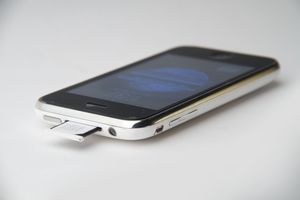
Most iPhones are sold with a SIM lock, which restricts the use of the phone to one particular carrier, a common practice with subsidized GSM phones. Unlike most GSM phones however, the phone cannot be officially unlocked by entering a code. The locked/unlocked state is maintained on Apple's servers per IMEI and is set when the iPhone is activated.
While the iPhone was initially sold in the US only on the AT&T network with a SIM lock in place, various hackers have found methods to "unlock" the phone from a specific network.[184] Although AT&T is the only authorized iPhone carrier in the United States, unlocked iPhones can be used with other carriers after unlocking.[185] More than a quarter of the original iPhones sold in the United States were not registered with AT&T. Apple speculates that they were likely shipped overseas and unlocked, a lucrative market before the iPhone 3G's worldwide release.[186] Unlocking iPhones in the U.S. is done because many would-be users dislike being tied to AT&T or consider their monthly fees too expensive.[15][المصدر لا يؤكد ذلك]
AT&T has stated that the "iPhone cannot be unlocked, even if you are out of contract".[185][187] On March 26, 2009 AT&T in the United States began selling the iPhone without a contract, though still SIM-locked to their network.[188] Such iPhone units are often twice as expensive as those with contracts, because Apple and AT&T lose the deferred income.[189]
Other carriers such as Verizon Wireless have been forced by the AT&T monopoly to focus on other types of smart phones such as those based on the Android (operating system).[190]
Outside of the United States, policies differ. O2, Orange, 3 and Vodafone in the المملكة المتحدة. The new iPhone 4 in the UK will be unlocked for use on any network.[بحاجة لمصدر] Also, four major carriers in Australia, (Three, Optus, Telstra, and Vodafone),[191] offer legitimate unlocking.[69] In some countries, including South Africa, Singapore, Greece, Taiwan, China, Hong Kong, Italy, New Zealand and Russia, vendors sell iPhones not locked to any carrier.[69]
انظر أيضاً
- Similar Apple Devices
- Newton – iPhone predecessor
- Smartphone
- Criticism of Apple Inc.
- iPhone models
- iPhone (original) – First generation iPhone with touchscreen interface
- iPhone 3G – Second generation iPhone with 3G and GPS
- iPhone 3GS – Third generation iPhone with improved camera and performance
- iPhone 4 – Fourth generation iPhone, features include higher megapixel camera, HD video, and improved performance
الهامش
- ^ "iPhone manufacturer to pay family of dead worker". CNET.com. Retrieved 2010-04-06.
- ^ "Steve iPhone: Hundreds Come, Lines Orderly". MP3 Newswire. June 29, 2007. Retrieved 2008-06-06.
- ^ "Apple Has Sold 450,000 iPads, 50 Million iPhones To Date". TechCrunch. April 8, 2010. Retrieved May 11, 2010.
- ^ "iPod and iPhone Battery and Power Specifications". iPodBatteryFAQ.com. Retrieved 2009-05-12.
- ^ "Apple (Samsung S5L8900) applications processor with eDRAM". SUBM TechInsights. Retrieved May 12, 2009.
- ^ Honan, Mathew (2007-01-09). "Apple unveils iPhone". Macworld. Retrieved 2008-04-06.
- ^ http://www.apple.com/iphone/apps-for-iphone/
- ^ أ ب Cohen, Peter (January 9, 2007). "Macworld Expo Keynote Live Update". Macworld. Retrieved 2007-02-01.
- ^ "The Untold Story: How the iPhone Blew Up the Wireless Industry". Wired. 9 January 2008.
{{cite web}}: Italic or bold markup not allowed in:|publisher=(help) - ^ Lewis, Peter (January 12, 2007). "How Apple kept its iPhone secrets". CNN Money. Retrieved 2009-01-11.
- ^ Vogelstein, Fred (January 9, 2008). "The Untold Story: How the iPhone Blew Up the Wireless Industry". Wired News. Condé Nast Publications. Retrieved 2008-01-10.
- ^ "Apple Inc. Q3 2007 Unaudited Summary Data" (PDF). Apple Inc. July 25, 2007. Retrieved 2008-06-06.
Consists of iPhones and Apple-branded and third-party iPhone accessories.
- ^ Costello, Sam. "Initial iPhone 3G Country Availability List". about.com. Retrieved 2009-01-11.
- ^ "iPhone 3G Coming to countries everywhere". Apple Inc. Retrieved 2009-04-12.
- ^ أ ب "iPhone 3G Price Decrease Addresses Key Reason Consumers Exhibit Purchase Resistance". NPD Group. 2009-06-22. Retrieved 2009-06-27.
- ^ أ ب ت ث "iPhone Users Watch More Video... and are Older than You Think". The Nielsen Company. 2009-106-10. Retrieved 2009-06-27.
{{cite web}}: Check date values in:|date=(help) - ^ "Apple Reports First Quarter Results". Apple. 2009-01-21.
- ^ أ ب "Apple Reports Second Quarter Results". Apple. 2009-04-22. For additional sales information, see the table of quarterly sales.
- ^ "Apple iPhone 3G sales surpass RIM's Blackberry". AppleInsider. October 21, 2008.
- ^ "Apple, AT&T mum on iPhone 3G issues". CNET Networks. Retrieved 2008-09-23.
- ^ Pogue, David (2007-06-27). "The iPhone Matches Most of its Hype". The New York Times. Retrieved 2009-06-27.
- ^ Mossberg, Walter (2008-07-08). "Newer, Faster, Cheaper iPhone 3G". All Things Digital. Retrieved 2009-06-27.
- ^ Mossberg, Walter (2009-06-17). "New iPhone Is Better Model–Or Just Get OS 3.0". All Things Digital. Retrieved 2009-06-27.
- ^ أ ب "iPhone Delivers Up to Eight Hours of Talk Time" (Press release). Apple Inc. June 18, 2007.
- ^ Fingerworks, Inc. (2003). "iGesture Game Mode Guide". www.fingerworks.com. Retrieved 2009-04-30.
- ^ Wilson, Tracy. "How the iPhone Works". How Stuff Works. Retrieved 2008-06-06.
- ^ أ ب Pogue, David (January 11, 2007). "The Ultimate iPhone Frequently Asked Questions". The New York Times. Retrieved 2008-06-06.
- ^ Pogue, David (January 13, 2007). "Ultimate iPhone FAQs list, Part 2". The New York Times. Retrieved 2008-06-06.
- ^ "How the iPhone's touchscreen Works". How Stuff Works. Retrieved 2008-06-06.
- ^ Slivka, Eric (2009-06-10). "More WWDC Tidbits: iPhone 3G S Oleophobic Screen, "Find My iPhone" Live". Mac Rumors. Retrieved 2009-07-03.
- ^ Johnson, R. Collin (July 9, 2007). "There's more to MEMS than meets the iPhone". EE Times. Retrieved 2008-06-06.
- ^ "iPod touch — A Guided Tour". Apple Inc. Retrieved 2008-09-23.
- ^ أ ب ت ث ج ح "The most advanced mobile OS. Now even more advanced". Scott Forstall's presentation (QuickTime video). Apple. 2009-03-17. Retrieved 2009-04-01.
- ^ أ ب ت ث ج ح Cohen, Peter (2009-03-17). "Cut and paste, MMS highlight iPhone 3.0 improvements". Macworld. Retrieved 2009-04-01.
- ^ أ ب "Apple Enhances Revolutionary iPhone with Software Update". Apple. January 15, 2008. Retrieved 2008-12-13.
- ^ XFF et al. (2008-06-13). "Memo: iPhone does not use triangulation". HowardForums. Retrieved 2009-06-01.
- ^ أ ب "Apple — iPhone — Get directions with GPS maps and a new compass". Apple. 2009-06-08. Retrieved 2009-06-08.
- ^ "Apple - iPhone 4 - Size, weight, battery life, and other specs". Apple. Archived from the original on 2010-07-01. Retrieved 1 July 2010.
- ^ "tip and ring". Computer Desktop Encyclopedia. The Computer Language Company Inc. Retrieved 2009-03-15.
- ^ أ ب German, Kent (June 29, 2007). "Apple iPhone – 8 GB (AT&T)". Cnet review. pp. 1 and 2. Retrieved 2009-01-10.
{{cite web}}: Unknown parameter|coauthors=ignored (|author=suggested) (help) - ^ "That damned recessed iPhone headphone jack". ZDNet. Retrieved 2008-06-06.
- ^ Frakes, Dan (May 14, 2008). "Review: iPhone headsets". Macworld. Retrieved 2009-01-10.
- ^ أ ب "Apple Earphones with Remote and Mic". Apple Store. Retrieved 2009-05-19.
- ^ Sadun, Erica (2009-01-26). "iBluetooth team achieves OBEX file transfer". Ars Technica. Retrieved 2009-05-12.
- ^ "Apple Component AV Cable". Apple Online Store. Apple Inc.
- ^ Oryl, Michael (July 3, 2007). "Review: Apple iPhone, In-Depth". Mobile Burn. Retrieved 2009-01-10.
- ^ "Hit the Road, Mac: iPod Power Aid". Mac|pages=32–33|date=June 2009|issue=29|unused_data=Life.
- ^ "Batteries—iPhone". Apple Inc. Retrieved 2008-06-06.
- ^ أ ب "Apple — iPhone — Technical Specifications". Apple Inc. Retrieved 2009-06-10.
- ^ "Apple — iPhone — Technical Specifications". Apple Inc. Retrieved 2009-06-10.
- ^ Cheng, Jacqui (2008-07-14). "The Second Coming: Ars goes in-depth with the iPhone 3G". Ars Technica. Retrieved 2009-06-23.
{{cite web}}: Unknown parameter|coauthors=ignored (|author=suggested) (help) - ^ Lam, Brian (2008-07-11). "iPhone 3G Review". Gizmodo.
{{cite web}}: Text "2009-06-23" ignored (help) - ^ Kramer, Staci D. (2008-07-09). "First iPhone 3G Reviews: Mossberg: Battery 'Significant Problem'; Pogue: Limited 3G, Good Audio". The Washington Post. Retrieved 2009-06-23.
- ^ Mossberg, Walter S (2008-07-08). "Newer, Faster, Cheaper iPhone 3G". The Wall Street Journal. Retrieved 2009-06-23.
- ^ "2008 Business Wireless Smartphone Customer Satisfaction Study". J. D. Power and Associates. 2008-11-06. Retrieved 2009-06-10.
- ^ Krazit, Tom (2008-11-06). "Apple's iPhone wins J.D. Power award". CNET. Retrieved 2009-06-10.
- ^ "iPhone Service Frequently Asked Questions". Apple Inc. Retrieved 2008-06-06.
- ^ أ ب Lee, Ellen (July 11, 2007). "Will a Cheaper iPhone click before Christmas?". San Francisco Chronicle. Retrieved 2008-06-06.
- ^ Wong, May (2007-07-08). "Apple Issues Battery Program for IPhone". The Washington Post. Retrieved 2007-07-08.
- ^ "iPhone's first sketchy battery replacement kit appears". Engadget. July 31, 2007.
- ^ Wilson, Mark (July 10, 2008). "The iPhone 3G Battery Is Quasi-Replaceable". Gizmodo. Retrieved 2009-01-10.
- ^ "Apple — iPhone 3Gs — Technical Specifications". Apple Inc. Retrieved 2010-06-21.
- ^ "Foundry's RollingShutter can Fix iPhone Jellocam". Hand Held Hollywood. 2009-11-16. Retrieved 2010-02-24.
- ^ "Apple — iPhone 4 — Technical Specifications". Apple Inc. Retrieved 2010-06-21.
- ^ "Apple kills 4 GB iPhone, cuts 8 GB price to $399 – iPhone Atlas". iPhone Atlas. September 5, 2007.
- ^ "Apple offers 16 GB iPhone, 32 GB iPod touch". Macworld. February 6, 2008.
{{cite news}}: Text "http://www.macworld.com/article/131959/2008/02/iphoneipodtouch.html" ignored (help) - ^ "Removing SIM card". Apple Inc. 2008-07-10. Retrieved 2009-06-11.
- ^ Diaz, Jesus (June 9, 2008). "iPhone 3G's New SIM Ejector Tool Makes It Instant Must-Buy". Gizmodo (in الإنگليزية). Gawker Media. Retrieved 2008-06-24.
{{cite news}}: CS1 maint: unrecognized language (link) - ^ أ ب ت "About activating iPhone 3G with a wireless carrier". Apple Inc. December 13, 2008. Retrieved 2008-12-14.
- ^ Apple Inc. "iPhone 4 – Size, weight, battery life, and other specs". Apple. Retrieved 2010-06-23.
- ^ Charlie Sorrel (October 16, 2007). "IPhone Water Sensor Revealed". Wired. Retrieved November 5, 2009.
- ^ David Martin (April 8, 2009). "Sweaty workouts killing iPhones?". Cnet. Retrieved November 5, 2009.
- ^ Lisa Respers (April 14, 2009). "Moisture, cold irritate some smart phone users". CNN. Retrieved November 5, 2009.
- ^ "Apple iPhone 3G Dock". Apple Store. Retrieved 2009-06-14.
- ^ "Apple — Support — Apple Ultracompact USB Power Adapter Exchange Program". Apple Inc. Retrieved 2009-01-09.
- ^ "Apple — Support — Apple Ultracompact USB Power Adapter Exchange Program — Latin American Countries". Apple Inc. Retrieved 2009-01-09.
- ^ "How Multitasking Works in the New iPhone OS 4.0". Gizmodo.com. 2010-04-08. Retrieved 2010-06-23.
- ^ "iPhone and iPod touch: Charging the battery". Apple. October 15, 2009. Retrieved January 12, 2010.
- ^ "iPhone 3GS & iPhone 4 – Apple Store (U.S.)". Store.apple.com. Retrieved 2010-06-23.
- ^ Engadget. "New iPhone 3GS 8GB features redesigned box with iOS 4". Engadget. Retrieved 2010-06-26.
- ^ "iPhone 4 Confirmed to Have 512 MB of RAM (Twice the iPad and 3GS)". Mac Rumors. 2010-06-17. Retrieved 2010-06-23.
- ^ Apple Inc. "iPhone 4 – Design of the display, A4 processor, and more". Apple. Retrieved 2010-06-23.
- ^ أ ب Haslam, Karen (January 12, 2007). "Macworld Expo: Optimised OS X sits on 'versatile' flash". Macworld. Retrieved 2008-06-06.
- ^ "iPhone: Minimum system requirements". Apple Inc. Retrieved 2007-07-13.
- ^ ""Apple's iTunes 7.6 plays nice with 64 bit Vista"". Engadget. January 15, 2008. Retrieved 2008-01-22.
- ^ "iTunes is now 64-bit". PlanetAMD64.
- ^ "To Upgrade or Not: the iPhone 3G S Dilemma". Macworld Canada. June 24, 2009. Retrieved 2009-06-27.
- ^ "Coming Soon: iPhone Software Updates". BusinessWeek. July 10, 2007. Retrieved 2008-06-06.
{{cite news}}:|first=missing|last=(help); Unknown parameter|laste=ignored (help) - ^ Cohen, Peter (2008-09-12). "Apple releases iPhone 2.1 update". Macworld. Retrieved 2009-06-10.
- ^ Aviv (August 12, 2008). "iPhone 3G Connection Issues Caused by Immature Infineon Chipset?". MacBlogz. Retrieved 2008-12-17.
- ^ "Apple — iPhone — Features — Home screen". Apple Inc. 2008. Retrieved 2008-12-13.
- ^ "iPhone Applications". Apple Inc. July 11, 2007. Retrieved 2007-11-04.
- ^ Melanson, Donald (2007-09-13). "Mirror-based video conferencing developed for iPhone". Engadget. Retrieved 2009-12-20.
- ^ "Apple – iPhone 4 – One-tap video calling with FaceTime on iPhone 43". Retrieved 2010-06-11.
- ^ Tessler, Franklin (2008-12-12). "Review: iPhone voice dialers". Macworld. Retrieved 2009-05-09.
- ^ أ ب "iPhone: Make calls and play music using voice control". Apple. 2009-06-10. Retrieved 2009-06-10.
- ^ Starrett, Charles (2008-06-11). "iPhone 3G carriers, Apple vary on Visual Voicemail". iLounge. Retrieved 2009-05-24.
- ^ "Apple Unveils the iTunes Wi-Fi Music Store". Apple. 2007-11-05. Retrieved 2009-05-24.
- ^ "How to create custom ringtones in GarageBand 4.1.1". Apple Inc. Retrieved 2007-12-15.
- ^ Gilbertson, Scott (September 12, 2007). "How to Make Custom IPhone Ringtones Without Paying Apple $2". Wired magazine. Condé Nast Publications. Retrieved 2008-03-08.
- ^ "What is Gapless Playback?". Apple Inc. Retrieved 2008-05-13.
- ^ Gruber, John (September 30, 2007). "The Reason It's Called the Wi-Fi Music Store". Linked List. Daring Fireball. Retrieved 2008-01-06.
- ^ "Apple's Joswiak: iPhone 3G Runs Fast HSDPA 3.6, Not Slower 1.8". Gearlog. Retrieved 2008-10-12.
- ^ Michaels, Philip (2009-06-08). "iPhone 3GS offers speed boost, video capture". Macworld. Retrieved 2009-06-08.
{{cite web}}: Unknown parameter|coauthors=ignored (|author=suggested) (help) - ^ Rojas, Peter (July 20, 2004). "AT&T Wireless introduces 3G wireless". Engadget. Retrieved 2008-12-17.
- ^ "Jobs: battery life issues delaying 3G iPhone". MacNN. Retrieved 2008-06-06.
- ^ "Apple — iPhone — Enterprise". Apple Inc. Retrieved 2008-06-11.
- ^ "iPhone: About Connections Settings". Apple Inc. Retrieved 2007-11-04.
- ^ "iPhone: Connecting to the Internet with EDGE or Wi-Fi". Apple Inc. Retrieved 2007-11-04.
- ^ "Apple -iPhone — Features – 3G". Apple Inc. 2008. Retrieved 2008-12-14.
- ^ "iPhone 3G S features 7.2 Mbit/s, AT&T's network does not". MacWorld. June 10, 2009. Retrieved May 16, 2010.
- ^ "Apple Increases iPhone Download Limit to 20 MB". February 19, 2010. Retrieved May 16, 2010.
- ^ "iPhone: Beat 10 MB 3G download limit".
- ^ "iPhone: Zooming In to See a Page More Easily". Apple Inc. Retrieved 2007-11-04.
- ^ Walter S. Mossberg (June 26, 2007). "The iPhone Is a Breakthrough Handheld Computer". The Mossberg Solution.
The iPhone is the first smart phone we've tested with a real, computer-grade Web browser, a version of Apple's Safari. It displays entire Web pages, in their real layouts, and allows you to zoom in quickly by either tapping or pinching with your finger.
{{cite news}}: Unknown parameter|coauthors=ignored (|author=suggested) (help) - ^ Chartier, David (June 12, 2007). "It's official: No Flash support on the iPhone (yet)". The Unofficial Apple Weblog. Retrieved 2008-06-06.
- ^ "BTW, I love Apple!". March 9, 2008. Retrieved 2008-05-07.
- ^ "ASA Adjudications: Apple (UK) Ltd". 2008-08-27. Retrieved 2009-03-10.
- ^ Jobs, Steve (April 2010). "Thoughts on Flash". Apple. Retrieved 2010-05-01.
- ^ Wilson, Ben (March 8, 2008). "iPhone OS 2.0 will include Bonjour, full-screen Safari mode, more". iPhone Atlas. Retrieved 2009-01-09.
- ^ riactant (August 27, 2007). "Apple iPhone Tech Talk Debriefing — Part 2 (Vector graphics and animation)". The General Theory of RIAtivity. Retrieved 2009-01-09.
- ^ Block, Ryan (January 9, 2007). "Live from Macworld 2007: Steve Jobs keynote". Engadget. Retrieved 2008-06-06.
- ^ أ ب Snell, Jason (2008-11-21). "Apple releases iPhone 2.2 update". Macworld. Retrieved 2009-06-10.
- ^ Lane, Slash (February 14, 2008). "Google iPhone usage shocks search giant". AppleInsider. Retrieved 2008-02-18.
- ^ "iPhone Data Booms at T-Mobile". Unstrung. January 30, 2008. Retrieved 2008-02-18.
- ^ "iPhone Goes to China Without Wi-Fi".
- ^ Markoff, John (June 13, 2007). "That iPhone Has a Keyboard, but It's Not Mechanical". The New York Times. Retrieved 2008-06-06.
- ^ "Apple — iPhone — Features — Keyboard". Apple Inc. Retrieved 2008-12-15.
- ^ "Apple — iPhone — Enterprise". Apple. Retrieved 2009-05-16.
- ^ Frausto-Robledo, Anthony (July 24, 2007). "Analysis: Kerio MailServer delivers email to Apple iPhone". Retrieved 2008-06-06.
- ^ "iPhone to support Exchange". TechTraderDaily. Barron's. March 6, 2008.
- ^ أ ب "Apple Introduces the New iPhone 3G". Apple Inc. June 9, 2008.
iPhone 2.0 software will be available on July 11 as a free software update via iTunes 7.7 or later for all iPhone customers
- ^ "iPhone—Features—Mail". Apple Inc. Retrieved 2009-05-16.
- ^ Moren, Dan (2008-01-16). "First Look: iPhone 1.1.3". Macworld. Retrieved 2009-06-10.
- ^ Mies, Ginny (2009-06-09). "AT&T tight-lipped on MMS, tethering". Macworld. Retrieved 2009-06-10.
- ^ "AT&T slates iPhone MMS launch for Friday". ComputerWorld. 2009-09-24. Retrieved 2009-09-25.
- ^ "iPhone to Support Third-Party Web 2.0 Applications". Apple Inc. June 11, 2007. Retrieved 2008-12-15.
- ^ "Live from Apple's iPhone SDK press conference". Engadget. March 6, 2008.
- ^ Quinn, Michelle (July 10, 2008). "Apple will open App Store in bid to boost iPhone sales". Los Angeles Times. Retrieved 2008-07-10.
- ^ Breen, Christopher (2008-07-15). "Is the iPod touch 2.0 update worth $10?". Macworld. Retrieved 2009-05-16.
- ^ "IPhone Software Sales Take Off: Apple's Jobs". Archived from the original on 2008-08-11. Retrieved 2008-09-03.
- ^ "Podcasting app rejected from App Store". Macworld. 2008-09-12. Retrieved 2009-01-23.
- ^ Raphael, JR (September 15, 2008). "Apple App Store Ban: Android, Here's Your Chance". PC World. Retrieved 2008-12-13.
- ^ "Apple — Web apps". Apple. Retrieved 2009-05-16.
- ^ Healey, Jon (August 6, 2007). "Hacking the iPhone". Los Angeles Times. Retrieved 2008-06-06.
- ^ "Apple's Joswiak: We Do not Hate iPhone Coders". gearlog.com. September 2007.
- ^ "Apple — Accessibility — iPhone — Vision". Apple. Retrieved 2008-12-15.
- ^ "Apple — Accessibility — iPhone — Hearing". Apple. Retrieved 2008-12-15.
- ^ "Apple — iPhone — Accessibility". Apple. 2009-06-08. Retrieved 2009-06-08.
- ^ "Apple — Voluntary Product Accessibility Templates". Apple. 2009-07-18. Retrieved 2009-07-18.
- ^ Ishimaru, Heather (January 9, 2007). "Apple Options Not An Issue At Macworld". abc7news.com. Retrieved 2007-01-11.
- ^ "iPhone — Features — High Technology". Apple Inc. Retrieved 2008-06-06.
- ^ Wright, Aaron (February 20, 2007). "The iPhone Lawsuits". Apple Matters. Retrieved 2007-06-25.
- ^ أ ب ت ث "Trademark Applications and Registrations Retrieval, serial number 74431935 (I PHONE)". United States Patent and Trademark Office. January 12, 2007. Retrieved 2008-06-06.
- ^ أ ب Berlind, David (January 7, 2007). "On the eve of a new phone, Apple appears to want in on Cisco's "iPhone" trademark". Retrieved 2009-01-10.
- ^ "Trademark Applications and Registrations Retrieval, serial number 75076573 (IPHONE)". United States Patent and Trademark Office. July 31, 2006. Retrieved 2008-06-06.
- ^ Needle, David (June 10, 1999). "InfoGear upgrades phone of the future". CNN. Retrieved 2007-01-27.
- ^ "InfoGear Technology Corporation v iPhones". National Arbitration Forum. April 13, 2000. Retrieved 2008-06-06.
- ^ أ ب Kawamoto, Dawn (January 26, 2007). "Cisco faces iPhone trademark challenge in Canada". ZDNet. Retrieved 2008-06-06.
- ^ Smith, Tony (December 18, 2006). "iPhone launched ... but not by Apple". The Register. Retrieved 2008-06-06.
- ^ "Case details for Community Trade Mark E5341301". UK Intellectual Property Office. Retrieved 2008-06-06.
- ^ "Apple filing for iPhone trademarks worldwide". 10layers.com. October 17, 2006. Retrieved 2007-01-28.
- ^ Thomas, Owen (January 9, 2007). "Apple: Hello, iPhone". CNN Money. Retrieved 2007-01-27.
- ^ "Cisco Sues Apple for Trademark Infringement" (Press release). Cisco Systems. January 10, 2007. Retrieved 2008-06-06.
- ^ Reuters (January 25, 2007). "Report: Cisco CEO calls iPhone suit 'minor skirmish'". News.com. Retrieved 2008-06-06.
{{cite news}}:|author=has generic name (help) - ^ Wong, May (February 2, 2007). "Cisco, Apple decide to talk over iPhone". Seattle Times. Associated Press. Retrieved 2008-06-06.
- ^ Wingfield, Nick (February 22, 2007). "Apple, Cisco Reach Accord Over iPhone" (fee required). Wall Street Journal. Retrieved 2008-06-06.
- ^ "Cisco and Apple Reach Agreement on iPhone Trademark". Apple Inc. February 21, 2007. Retrieved 2008-04-01.
- ^ Gikas, Mike (2008-04-08). "Send in the iClones". Consumer Reports. Retrieved 2009-06-10.
- ^ Perepelkin, Plato (2008-09-01). "Cashing In on the Outdated iPhone" (PDF). PRWeb. Vocus. Retrieved 2009-04-08.
- ^ "Nokia sues Apple in Delaware District Court for infringement of Nokia GSM, UMTS and WLAN patents". Nokia. 2009-10-22. Retrieved 2009-10-24.
- ^ Johnston, Michael (2007-10-20). "Do iPhone Hacks Void Your Warranty?". iPhone Alley. Retrieved 2009-05-14.
- ^ Moren, Dan (2008-05-28). "iPhone hackers look to an uncertain future". Macworld. Retrieved 2009-05-25.
- ^ Johansen, Jon Lech (July 3, 2007). "iPhone Independence Day". nanocr.eu. Retrieved 2008-06-06.
- ^ Baldwin, Roberto (June 9, 2008). "iPhone 3G — In-Store Activation Only". MacLife. Retrieved 2008-06-13.
- ^ Markoff, John (July 12, 2008). "iPhone Users Plagued by Software Problems". The New York Times. Retrieved 2008-07-13.
- ^ "iPhone 3G". Apple Store (U.K.). Retrieved 2009-05-14.
- ^ "Apple — iPhone — Buy iPhone 3G". Apple. Retrieved 2009-06-14.
- ^ Krazit, Tom (2007-10-19). "iPhone jailbreak for the masses released". CNET news. Retrieved 2009-05-14.
- ^ Granick, Jennifer (2007-08-28). "Legal or Not, IPhone Hacks Might Spur Revolution". Wired. Retrieved 2009-05-14.
- ^ Krazit, Tom (February 23, 2009). "Apple: iPhone jailbreaking violates our copyright". News.com. Retrieved 2009-02-14.
- ^ Australian admits creating first iPhone virus, Brigid Andersen, ABC Online, 2009-11-09. Retrieved 2009-11-10.
- ^ "Jailbreaking puts iPhone owners at risk, says researcher".
- ^ Farivar, Cyrus (2007-11-14). "Unlocking an iPhone". Macworld. Retrieved 2009-05-25.
- ^ أ ب Kharif, Olga (2008-09-02). "What's Hot: Used Apple iPhones: After the iPhone 3G launch, consumers want the original, hackable iPhone, and vendors are springing up to sell them—for a premium". BusinessWeek. Retrieved 2009-03-17.
- ^ "Quarter of US iPhones 'unlocked'". BBC News. January 28, 2008.
- ^ "Answer Center: What is the unlock code for my iPhone?". AT&T. Retrieved 2009-05-13.
- ^ Krazit, Tom (2009-13-19). "AT&T: No-contract iPhones coming next week". CNET News. Retrieved 2009-05-14.
{{cite web}}: Check date values in:|date=(help) - ^ "Orange to sell iPhone SIM-free for €749". PC Retail Magazine. November 29, 2007. Retrieved 2008-01-06.
- ^ Ante, Spencer E. (2010-06-08). "Verizon Strives to Close iPhone Gap". Online.wsj.com. Retrieved 2010-06-23.
- ^ "iPhone 3G & iPhone 3GS – Apple Store (Australia)". Store.apple.com. Retrieved 2010-05-19.
وصلات خارجية
![]() تعريفات قاموسية في ويكاموس
تعريفات قاموسية في ويكاموس
![]() كتب من معرفة الكتب
كتب من معرفة الكتب
![]() اقتباسات من معرفة الاقتباس
اقتباسات من معرفة الاقتباس
![]() نصوص مصدرية من معرفة المصادر
نصوص مصدرية من معرفة المصادر
![]() صور و ملفات صوتية من كومونز
صور و ملفات صوتية من كومونز
![]() أخبار من معرفة الأخبار.
أخبار من معرفة الأخبار.
- Official website
- Technical specifications (all models)
- iPhone at the Open Directory Project
- Video of Jobs launching the iPhone at Macworld 2007
- CS1 errors: markup
- CS1 errors: unsupported parameter
- CS1 errors: unrecognized parameter
- CS1 errors: missing name
- CS1 errors: generic name
- مقالات فيها عبارات متقادمة منذ أبريل 2010
- جميع المقالات التي فيها عبارات متقادمة
- Articles with hatnote templates targeting a nonexistent page
- Vague or ambiguous time
- Articles with unsourced statements
- Articles with unsourced statements from May 2010
- مقالات ذات عبارات بحاجة لمصادر
- Portal-inline template with redlinked portals
- Pages with empty portal template
- 2007 introductions
- Apple Inc. mobile phones
- Apple personal digital assistants
- Cloud clients
- Digital audio players
- IPhone
- IOS (Apple)
- IPod
- ITunes
- Multi-touch
- Portable media players
- هواتف ذكية
- Touchscreen mobile phones
- Touchscreen portable media players
- Wi-Fi devices
